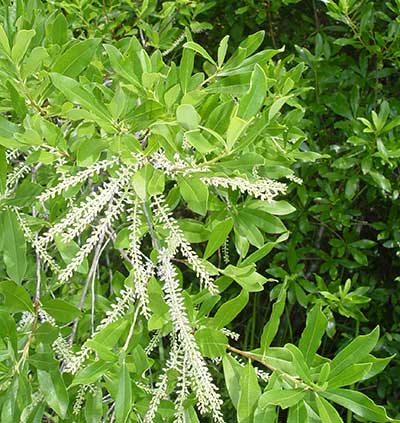
Gardening Event: Got Plant Problems? Get Free Help!
Becky Jordi will conduct a Plant Clinic July 21, 2014 from 10 am until 2 pm at the Yulee Extension Office (A1A and Pages Dairy Road). All Nassau County residents are invited to bring plant samples showing problems in their landscapes. “Bring your tired, diseased, insect infested plants yearning to be free of problems.” When possible place your plant in a plastic bag to prevent chances of spreading issues to other plants. Receive current researched based information on proper plant care, disease management and insect control. These sessions are free to the public. No registration required. Come anytime between 10 am – 2 pm for expert advice. Problems will be identified and solutions offered for correction. For more information call 904-879-1019. Also, Master Gardeners are on phone duty every Friday at 904-491-7340 to answer gardening and landscape questions.
QUESTION: I found this pretty, lilac wildflower growing near a ditch in my neighborhood. Can you tell me what it is and can I dig it up and plant it in my yard. LL
JORDI: I consulted the University of Florida Herbarium to be sure my guess was correct and they agree the wildflower is probably a false dragonhead in the genus, Physostegia. Physostegia is from Greek physa “bladder” and stege “covering”, in reference to the somewhat inflated a calyx. A calyx is the green leaf-like sepals which enclose the petals and forms a protective layer around a flower in bud.
Some species in this genus go by the name obedient-plant because the flowers remain temporarily in place when pushed to one side. False Dragonhead is best planted in rich, moist soil in full sun or light shade. False Dragonhead has 1 inch tubular flowers tightly clustered in long spikes at the top of stems and grows wild in moist ground in prairies, edges of glades and along streams. The leaves are opposite with toothed edges, up to 5 inches long, becoming smaller in size as the flower head develops. The stem is four-sided (roughly square in cross section,) as is typical of members of the mint family. False dragonhead is sometimes used as an ornamental and the “Obedient Plant” name really does not apply to the plant in cultivated gardens as these plants can be aggressive colonizers.
Regarding picking or removing wildflowers illegally from wildlife areas here is the USDA Forest service comment: “Almost all wildflowers are fragile and many wilt and perish soon after being picked. Over the years, the repercussions of wildflower picking by unthinking people go far beyond the loss of the flowers themselves. A critical chain of events is triggered for years to come once wildflowers are lost. We don’t often realize it, but wildflowers support entire ecosystems for pollinators, birds, and small animals on a micro scale. Butterflies and other insects, small birds, and animals depend on seeds, nectar, and pollen for their food supply and life support system. In addition, some pollinators are not very mobile or have very small home ranges or depend on just one species of plant and die once their habitat has been destroyed.” The complete article, “Wildflower Ethics and Native Plants”
QUESTION: What is the shrub growing along the roadside which has five finger like flower structures? I have never noticed it before and it appears to be everywhere. LC
JORDI: Thanks for bringing in a clipping which made it easier for me to identify. 
White Titi plant should not be confused with spring Titi, black Titi or the Buckwheat tree, Cliftonia monophylla. The photo seen here is of the White Titi tree. Let’s look at the trees a little more closely and make some comparisons. White Titi is deciduous (drops its leaves in the fall) whereas the Buckwheat tree is evergreen. The flower of the White Titi has the long (3-6 inches), finger-like structures blooming downward in the late spring to early summer. The flowers of the Buckwheat are small, white to pink, 5 petals, occurring in upright clusters at the branch tips, 2 – 4 inches long, appearing in spring. The fruit of the White Titi is long whereas the fruit of the Buckwheat tree is rounded and winged similar to a buckwheat achene.
QUESTION: My neighbor has planted a bromeliad in full sun. I thought they all had to be grown in shade. JD
JORDI: Bromeliads come from a wide range of environments, from areas with deep shade to full sun, so chances are good you can find a bromeliad suitable for the amount of light your landscape receives. Light exposure can alter a bromeliad’s leaf color, leaf shape, and growth rate. If the light levels are too low for the variety then the leaves will become long, thin, and greener in color. If light levels are too high the leaves become shorter, thicker, and lighter in color, sometimes even the edges of the leaves will turn brown. Bromeliads have very shallow roots which are mainly used to anchor the plant so it is important to provide well drained soil which is moist but never wet. The ideal soil should consist of equal parts peat, bark and coarse sand. Attached is a publication from the University of Florida: http://edis.ifas.ufl.edu/ep337
In addition, this article was printed in the Bromeliad Society Newsletter and lists some full sun bromeliads for South Florida. However, do note, these bromeliads may not be able to handle the colder temperatures of Northeast Florida: http://fcbs.org/articles/full-sun-bromeliads.htm

Nassau County Extension Director
UF/IFAS Environmental Horticulture
543350 U.S. Highway #1
Callahan, FL 32011
904 491-7340 or 904 879-1019
Website: Nassau County Extension
